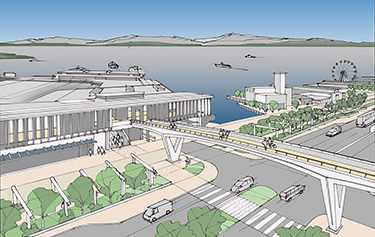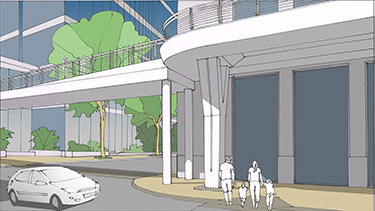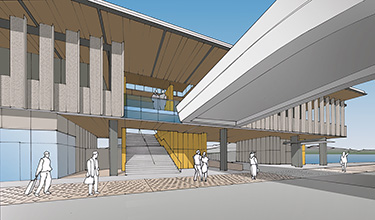|
Subscribe / Renew |
|
|
Contact Us |
|
| ► Subscribe to our Free Weekly Newsletter | |
| home | Welcome, sign in or click here to subscribe. | login |
Architecture & Engineering
| |

|
|
Design Perspectives By Clair Enlow |
January 16, 2019
Design Perspectives: The Marion Street Bridge still falls short
Special to the Journal
The age of highway expansion was not good for bridges. They were designed to be unseen, even when spanning a waterway. Some, like our floating bridges, are mostly underwater.
But invisibility is just not a good design strategy for a bazillion tons of concrete — unless it's underneath the ground like the new state Route 99 tunnel, or it creates new ground like the Olympic Sculpture Park.
The Alaskan Way Viaduct, 1953-2019, did a terrible job of disappearing.
It's really a giant highway bridge that is all awkwardly exposed because it happens to be high in the air. Its presence has been felt and heard more than seen.
It ran right over the Seattle waterfront just because it could — and because it was oh-so-nice for driving from West Seattle to North Seattle, and a few places in-between.
No one cared that it was ugly. There was no city design commission to look under the deck.
But bridge projects have been getting more visibility and respect in recent decades, thanks to engineers, architects and public clients who proudly collaborate on them.
There are household names in modern bridge design. Miguel Rosales is an architect who has made a reputation in bridge design, and he and his Boston-based firm — Rosales + Partners — have been working in Seattle with HDR on a long pedestrian bridge that will replace the Marion Street Bridge, spanning the space between First Avenue and the new Colman Dock Ferry Terminal. The structure serves walk-on ferry passengers.
The ferry terminal must be there first, but both projects are set to reopen in 2023. Bridge construction is expected to begin in 2021. It's a joint project between the city of Seattle and the state, with a price estimate of $20 million. The design was approved by the Seattle Design Commission this month, and it goes next to the Seattle City Council for final passage.
Just as in previous sketches, (see the DJC article at https://tinyurl.com/yb4wtmal), it arcs gracefully over Alaskan Way, touching down lightly with V-shaped piers. Unfortunately the design is still not finished, despite the design commission vote. It's no fault of the architects — the project is still just short of funding.
So it's a block-or-so short of a nice bridge.
Squeezing through
The eastern section of the old bridge will not be rebuilt — just remodeled a little to connect with the new one, which is about twice as wide.
The new bridge has been designed at 16 feet wide so that hurried passengers — bicycles, strollers and all — can dash to the pedestrian deck of the new terminal. But first they'll have to squeeze through the old Marion Street Bridge between First Avenue and Western Avenue.
Because the new Marion Street Bridge deck is a little higher, the connection with the old is a little like a disabilities accommodation, with the deck ramped to meet it. The connection is finessed with new railings on the old section. The sharp corner and right angle where the narrow old bridge meets the wide new one was rounded off for the final design review. It's the kind of improvement that gets a project a passing grade.
A second phase?
The old section of the bridge is called “Phase Two” in drawings. But design commission members were openly skeptical that it would ever actually be replaced in a second phase, perhaps because the old bridge section is shown with new railings, and there is no design to be seen for the replacement, Phase Two.
No angel is likely to fund a design that doesn't exist.
Member Rick Krochalis asked, “Why not do it right the first time?”
The west end of the bridge seems to fall a few feet short, too. It leaps toward its designated partner — the future, improved ferry terminal — but it doesn't seem to touch. Kind of like a concrete diving board.
OK. Bridge and ferry terminal can't be one structure, for very good reasons. They will shake at different rates. The physical connection, called an expansion joint, is hidden. This is all seismically correct, but couldn't they even shake hands, visually?
The concrete and steel railings of the bridge almost meet the terminal's glass ones, but it's clearly a standoff. All of us, from ferry commuters to passersby on the waterfront, would feel so much better if we thought they were getting along. Sure, they can't share structural support, but it would be reassuring to see some shared design vocabulary — materials, color or pattern — at least in the railings.
It could be that no amount of reverse-design can make up for the problems at either end of this bridge. Better funding and better communication on the project might have helped it before it passed the 90 percent design threshold. But there's still that 10 percent left.
Clair Enlow can be reached by e-mail at clair@clairenlow.com.
Previous columns:
- Will we really have a ‘Waterfront for All'?, 12-05-2018
- Design Perspectives: Battery Street group looks to other cities for ideas, 09-12-2018
- Design Perspectives: The Marion Street bridge design falls short, 08-08-2018
- Big changes in Seattle waterfront design merge Overlook Walk with Ocean Pavilion, 05-02-2018
- Design Perspectives: The real work along the waterfront is what you don't see, 03-14-2018
- Design Perspectives: Urban Visions' West Edge brings new apartments to downtown Seattle, 01-10-2018
- Design Perspectives: Waterfront design reaches another milestone, 12-20-2017
- Design Perspectives: A spare, smart studio at the edge of sustainability, 11-29-2017





